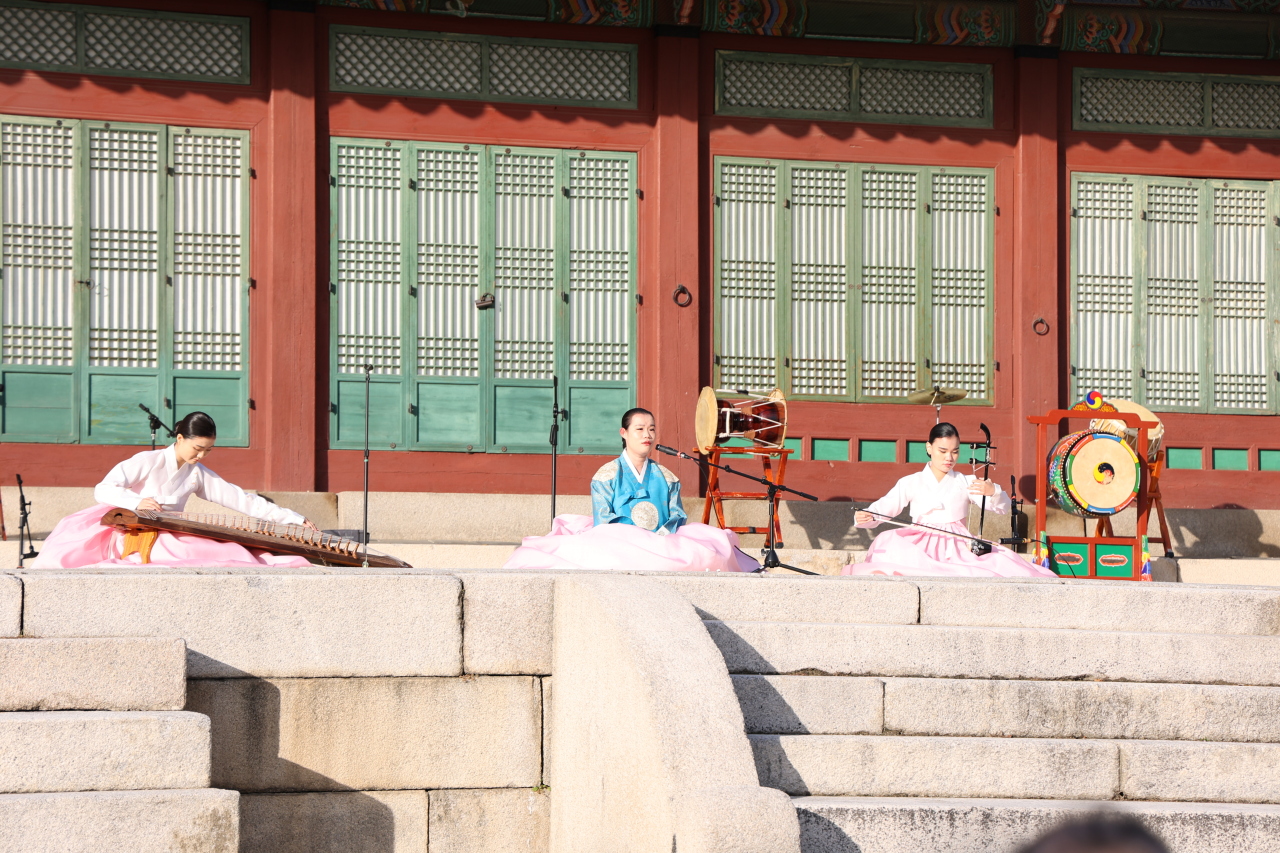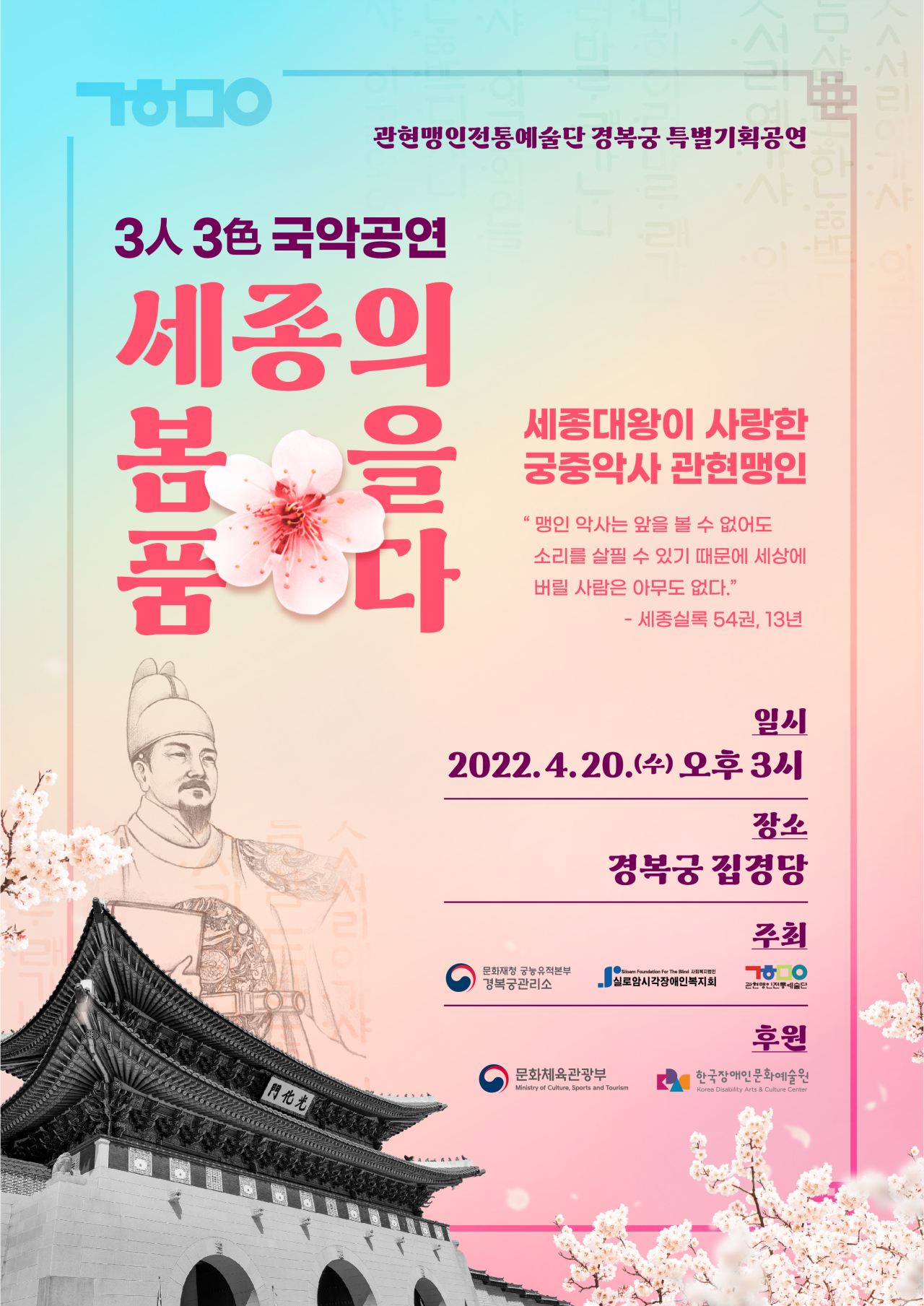Orchestra performance of the blind from Joseon to be reborn at Gyeongbok Palace
By Kim Hae-yeonPublished : April 18, 2022 - 14:21

To celebrate the nation’s Day for People with Disabilities on April 20, the Cultural Heritage Administration will hold a special performance played by leading musicians from the Korean Traditional Music Orchestra of the Blind, at Gyeongbok Palace on Wednesday.
Jointly hosted by the CHA’s Gyeongbok Palace Management Center and the Siloam Center for the Blind, this will be the second performance of its kind, after the first was held last year in the front yard of Sujeongjeon, the palace’s central court.
During the Joseon era (1392-1910), King Sejong invented a system for the musically gifted people with visual disabilities, and named it the Blind Kwanhyun, meaning the orchestra of the blind. While supporting music education and encouraging performances for royal festivities, some of those were given government posts as court musicians. Their outstanding expertise in music became widely known, and stood as one of the symbolic cultural performances in the palace history of Korea.
Jointly hosted by the CHA’s Gyeongbok Palace Management Center and the Siloam Center for the Blind, this will be the second performance of its kind, after the first was held last year in the front yard of Sujeongjeon, the palace’s central court.
During the Joseon era (1392-1910), King Sejong invented a system for the musically gifted people with visual disabilities, and named it the Blind Kwanhyun, meaning the orchestra of the blind. While supporting music education and encouraging performances for royal festivities, some of those were given government posts as court musicians. Their outstanding expertise in music became widely known, and stood as one of the symbolic cultural performances in the palace history of Korea.

This year’s performance named, “Embracing King Sejong’s Spring,” will be held indoors at Jipgyeongdang, the Joseon queen’s royal chamber at Gyeongbok Palace.
Three musicians will be playing traditional instruments -- geomungo, a six-stringed zither, daegeum, a large bamboo flute, and danso, a smaller flute -- and a song master of gasa, Korean traditional narrative song.
From solo performances to ensembles, the themes of the program range from appreciation of nature, to yearning for a peaceful world in harmony.
“Still not many are informed that there is an orchestra group consisting of people with visual disabilities, and we hope that the performance would serve to raise awareness of relevant communities and artists,” the CHA’s performance organizing team leader told The Korea Herald on Monday.
The Culture Ministry, since 2011, has steadily worked to carry on the cultural legacy of the Blind Kwanhyun system. The ministry’s support to Siloam Center for the Blind has led to job creations and opportunities for musicians having disabilities to build their professional careers, including the Korean Traditional Music Orchestra of the Blind.
Although this year’s performance will not invite additional guests onsite due to pandemic restrictions during its preparation period, the full performance video will be released on both the CHA’s and Korean Traditional Music Orchestra of the Blind’s YouTube channels, on May 20.
By Kim Hae-yeon (hykim@heraldcorp.com)
Three musicians will be playing traditional instruments -- geomungo, a six-stringed zither, daegeum, a large bamboo flute, and danso, a smaller flute -- and a song master of gasa, Korean traditional narrative song.
From solo performances to ensembles, the themes of the program range from appreciation of nature, to yearning for a peaceful world in harmony.
“Still not many are informed that there is an orchestra group consisting of people with visual disabilities, and we hope that the performance would serve to raise awareness of relevant communities and artists,” the CHA’s performance organizing team leader told The Korea Herald on Monday.
The Culture Ministry, since 2011, has steadily worked to carry on the cultural legacy of the Blind Kwanhyun system. The ministry’s support to Siloam Center for the Blind has led to job creations and opportunities for musicians having disabilities to build their professional careers, including the Korean Traditional Music Orchestra of the Blind.
Although this year’s performance will not invite additional guests onsite due to pandemic restrictions during its preparation period, the full performance video will be released on both the CHA’s and Korean Traditional Music Orchestra of the Blind’s YouTube channels, on May 20.
By Kim Hae-yeon (hykim@heraldcorp.com)


















![[KH Explains] Hyundai's full hybrid edge to pay off amid slow transition to pure EVs](http://res.heraldm.com/phpwas/restmb_idxmake.php?idx=652&simg=/content/image/2024/04/18/20240418050645_0.jpg&u=20240418181020)

![[Today’s K-pop] Zico drops snippet of collaboration with Jennie](http://res.heraldm.com/phpwas/restmb_idxmake.php?idx=642&simg=/content/image/2024/04/18/20240418050702_0.jpg&u=)